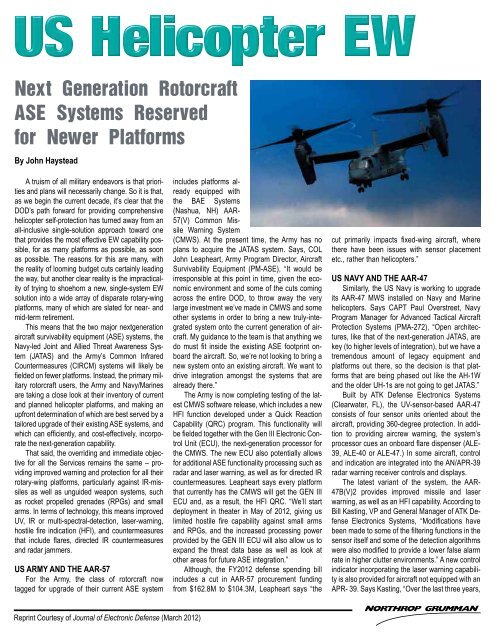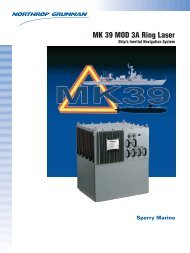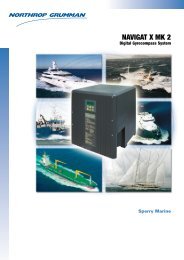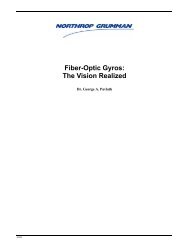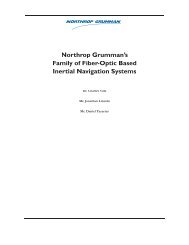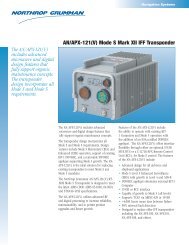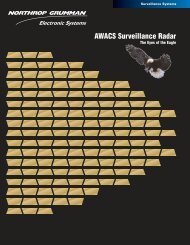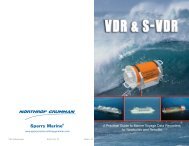Next Generation Rotorcraft ASE Systems Reserved for Newer ...
Next Generation Rotorcraft ASE Systems Reserved for Newer ...
Next Generation Rotorcraft ASE Systems Reserved for Newer ...
Create successful ePaper yourself
Turn your PDF publications into a flip-book with our unique Google optimized e-Paper software.
<strong>Next</strong> <strong>Generation</strong> <strong>Rotorcraft</strong><br />
<strong>ASE</strong> <strong>Systems</strong> <strong>Reserved</strong><br />
<strong>for</strong> <strong>Newer</strong> Plat<strong>for</strong>ms<br />
By John Haystead<br />
A truism of all military endeavors is that priorities<br />
and plans will necessarily change. So it is that,<br />
as we begin the current decade, it’s clear that the<br />
DOD’s path <strong>for</strong>ward <strong>for</strong> providing comprehensive<br />
helicopter self-protection has turned away from an<br />
all-inclusive single-solution approach toward one<br />
that provides the most effective EW capability possible,<br />
<strong>for</strong> as many plat<strong>for</strong>ms as possible, as soon<br />
as possible. The reasons <strong>for</strong> this are many, with<br />
the reality of looming budget cuts certainly leading<br />
the way, but another clear reality is the impracticality<br />
of trying to shoehorn a new, single-system EW<br />
solution into a wide array of disparate rotary-wing<br />
plat<strong>for</strong>ms, many of which are slated <strong>for</strong> near- and<br />
mid-term retirement.<br />
This means that the two major nextgeneration<br />
aircraft survivability equipment (<strong>ASE</strong>) systems, the<br />
Navy-led Joint and Allied Threat Awareness System<br />
(JATAS) and the Army’s Common Infrared<br />
Countermeasures (CIRCM) systems will likely be<br />
fielded on fewer plat<strong>for</strong>ms. Instead, the primary military<br />
rotorcraft users, the Army and Navy/Marines<br />
are taking a close look at their inventory of current<br />
and planned helicopter plat<strong>for</strong>ms, and making an<br />
upfront determination of which are best served by a<br />
tailored upgrade of their existing <strong>ASE</strong> systems, and<br />
which can efficiently, and cost-effectively, incorporate<br />
the next-generation capability.<br />
That said, the overriding and immediate objective<br />
<strong>for</strong> all the Services remains the same – providing<br />
improved warning and protection <strong>for</strong> all their<br />
rotary-wing plat<strong>for</strong>ms, particularly against IR-missiles<br />
as well as unguided weapon systems, such<br />
as rocket propelled grenades (RPGs) and small<br />
arms. In terms of technology, this means improved<br />
UV, IR or multi-spectral-detection, laser-warning,<br />
hostile fire indication (HFI), and countermeasures<br />
that include flares, directed IR countermeasures<br />
and radar jammers.<br />
US ARMY AND THE AAR-57<br />
For the Army, the class of rotorcraft now<br />
tagged <strong>for</strong> upgrade of their current <strong>ASE</strong> system<br />
Reprint Courtesy of Journal of Electronic Defense (March 2012)<br />
includes plat<strong>for</strong>ms already<br />
equipped with<br />
the BAE <strong>Systems</strong><br />
(Nashua, NH) AAR-<br />
57(V) Common Missile<br />
Warning System<br />
(CMWS). At the present time, the Army has no<br />
plans to acquire the JATAS system. Says, COL<br />
John Leapheart, Army Program Director, Aircraft<br />
Survivability Equipment (PM-<strong>ASE</strong>), “It would be<br />
irresponsible at this point in time, given the economic<br />
environment and some of the cuts coming<br />
across the entire DOD, to throw away the very<br />
large investment we’ve made in CMWS and some<br />
other systems in order to bring a new truly-integrated<br />
system onto the current generation of aircraft.<br />
My guidance to the team is that anything we<br />
do must fit inside the existing <strong>ASE</strong> footprint onboard<br />
the aircraft. So, we’re not looking to bring a<br />
new system onto an existing aircraft. We want to<br />
drive integration amongst the systems that are<br />
already there.”<br />
The Army is now completing testing of the latest<br />
CMWS software release, which includes a new<br />
HFI function developed under a Quick Reaction<br />
Capability (QRC) program. This functionality will<br />
be fielded together with the Gen III Electronic Control<br />
Unit (ECU), the next-generation processor <strong>for</strong><br />
the CMWS. The new ECU also potentially allows<br />
<strong>for</strong> additional <strong>ASE</strong> functionality processing such as<br />
radar and laser warning, as well as <strong>for</strong> directed IR<br />
countermeasures. Leapheart says every plat<strong>for</strong>m<br />
that currently has the CMWS will get the GEN III<br />
ECU and, as a result, the HFI QRC. “We’ll start<br />
deployment in theater in May of 2012, giving us<br />
limited hostile fire capability against small arms<br />
and RPGs, and the increased processing power<br />
provided by the GEN III ECU will also allow us to<br />
expand the threat data base as well as look at<br />
other areas <strong>for</strong> future <strong>ASE</strong> integration.”<br />
Although, the FY2012 defense spending bill<br />
includes a cut in AAR-57 procurement funding<br />
from $162.8M to $104.3M, Leapheart says “the<br />
cut primarily impacts fixed-wing aircraft, where<br />
there have been issues with sensor placement<br />
etc., rather than helicopters.”<br />
US NAVY AND THE AAR-47<br />
Similarly, the US Navy is working to upgrade<br />
its AAR-47 MWS installed on Navy and Marine<br />
helicopters. Says CAPT Paul Overstreet, Navy<br />
Program Manager <strong>for</strong> Advanced Tactical Aircraft<br />
Protection <strong>Systems</strong> (PMA-272), “Open architectures,<br />
like that of the next-generation JATAS, are<br />
key (to higher levels of integration), but we have a<br />
tremendous amount of legacy equipment and<br />
plat<strong>for</strong>ms out there, so the decision is that plat<strong>for</strong>ms<br />
that are being phased out like the AH-1W<br />
and the older UH-1s are not going to get JATAS.”<br />
Built by ATK Defense Electronics <strong>Systems</strong><br />
(Clearwater, FL), the UV-sensor-based AAR-47<br />
consists of four sensor units oriented about the<br />
aircraft, providing 360-degree protection. In addition<br />
to providing aircrew warning, the system’s<br />
processor cues an onboard flare dispenser (ALE-<br />
39, ALE-40 or ALE-47.) In some aircraft, control<br />
and indication are integrated into the AN/APR-39<br />
radar warning receiver controls and displays.<br />
The latest variant of the system, the AAR-<br />
47B(V)2 provides improved missile and laser<br />
warning, as well as an HFI capability. According to<br />
Bill Kasting, VP and General Manager of ATK Defense<br />
Electronics <strong>Systems</strong>, “Modifications have<br />
been made to some of the filtering functions in the<br />
sensor itself and some of the detection algorithms<br />
were also modified to provide a lower false alarm<br />
rate in higher clutter environments.” A new control<br />
indicator incorporating the laser warning capability<br />
is also provided <strong>for</strong> aircraft not equipped with an<br />
APR- 39. Says Kasting, “Over the last three years,
we’ve been in the process of upgrading nearly all<br />
fielded AAR-47 systems to the B(V)2 configuration.”<br />
RF WARNING AND THE APR-39<br />
Of all the <strong>ASE</strong> systems in service, the Northrop<br />
Grumman AN/APR-39 RWR, in its many versions,<br />
has to be the most widely installed across the DOD<br />
rotary-wing fleet, and the longest-lived. To date,<br />
over 6,000 APR-39 systems have been installed on<br />
both US and international rotorcraft plat<strong>for</strong>ms including<br />
the AH-1W/Z, UH-1N/Y, MV-22B, UH-60,<br />
OH-58D, CH-46/47/53, and AH-64A/D. Although,<br />
as observed by Overstreet, in recent conflicts such<br />
as Iraq and Afghanistan, RF threats have not proven<br />
as significant as IR and small arms fire <strong>for</strong> helicopter<br />
plat<strong>for</strong>ms, “who knows what the future will<br />
bring.”<br />
Already, the Libyan conflict has highlighted this<br />
point, but perhaps of even greater significance to<br />
the importance of the APR-39, is the role it plays on<br />
many helicopter plat<strong>for</strong>ms in also integrating and<br />
displaying warning data from other <strong>ASE</strong> sensors<br />
and systems. Integrated with both laser and missile<br />
warning systems, the newer versions of the APR-<br />
39 are increasingly serving as the overall controller<br />
<strong>for</strong> a helicopter’s <strong>ASE</strong> suite.<br />
Jeff Palombo, Northrop Grumman VP and General<br />
Manager, Land and Self Protection <strong>Systems</strong><br />
Division (Rolling Meadows, IL), says this is one of<br />
the larger next-capability functions <strong>for</strong> the AN/ APR-<br />
39. Working through the company’s <strong>Rotorcraft</strong> Avionics<br />
Innovation Laboratory (RAIL), Palombo says<br />
Northrop Grumman has been continually working<br />
to utilize and improve the APR- 39’s capabilities as<br />
an integrated <strong>ASE</strong> suite controller. “We’ve already<br />
demonstrated the ability to utilize all the targeted<br />
analog hardware on existing plat<strong>for</strong>ms, piping their<br />
in<strong>for</strong>mation into a same-<strong>for</strong>m-factor APR-39 where<br />
it is fused with the data from other sensors to provide<br />
an unambiguous, single set of threat in<strong>for</strong>mation<br />
to the pilot.” In 2010, the Army awarded<br />
Northrop Grumman a $450M IDIQ contract to upgrade<br />
770 APR-39s to the new configuration.In ad-<br />
dition, the Naval Air <strong>Systems</strong> Command announced<br />
last March that it intends to award a new sole<br />
source contract to Northrop Grumman to upgrade<br />
the APR-39 to a new AN/APR-39D(V)2 configuration.<br />
As described by Overstreet, “It’s essentially an<br />
ECP to the current system that corrects some current<br />
deficiencies and provides greater capability,<br />
but meets the same size and weight requirements<br />
of the current system.” As part of the upgrade, the<br />
39D(V2) will incorporate a new digital receiver to<br />
handle environments that include greater threat<br />
densities as well as more commercial and civilian<br />
emitters that must be sorted from the threats. “It’s<br />
one of the first <strong>for</strong>ays into digital receivers in a small<br />
<strong>for</strong>m factor <strong>for</strong> the helicopter community,” says<br />
Overstreet. “We’re leveraging our current APR-39<br />
production requirements <strong>for</strong> new helicopters and<br />
new MV-22s to upgrade to digital.” The MV-22 is<br />
the lead plat<strong>for</strong>m to receivethe upgrade.<br />
Although the Navy and Marines don’t currently<br />
have a jamming requirement <strong>for</strong> their rotary-wing<br />
aircraft, the size and<br />
weight savings offered<br />
by the digital receiver<br />
design raises the possibility<br />
of an electronic<br />
attack capability being<br />
incorporated into the<br />
APR-39D(V2) configuration.<br />
In fact, the Army<br />
has expressed interest<br />
in just that. Says Leapheart,<br />
“This is a great<br />
example of how the<br />
Services can work together.<br />
We’re watching<br />
the Navy’s ef<strong>for</strong>t very<br />
closely and hope to be able to get funding in the<br />
2014-18 timeframe to follow in the same path, both<br />
in terms of the digital RWR as well as having the<br />
potential to expand it into a jammer.”<br />
THE JOINT AND ALLIED THREAT AWARE-<br />
NESS SYSTEM (JATAS)<br />
When the Navy conceived its Joint and Allied<br />
Threat Awareness System (JATAS) program<br />
several years ago, it planned to replace most of<br />
its AAR-47 RWRs, (as well as all of its AAR-57s<br />
and Northrop Grumman AAR-54s), with the nextgeneration<br />
system that could per<strong>for</strong>m missile warning,<br />
laser warning and HFI. The Navy expected<br />
that fleet-wide installation of a common IR threat<br />
warning system would achieve modernization<br />
while limiting sustainment costs. However, the cost<br />
of buying and installing enough JATAS systems to<br />
cover most of the US Navy and USMC rotary-wing<br />
fleets is no longer viable in the constrained DOD<br />
budget. Overstreet now notes that “JATAS is designed<br />
<strong>for</strong> the smaller plat<strong>for</strong>ms” and says, beyond<br />
the lead MV-22B “Osprey” integration plat<strong>for</strong>m and<br />
Marine AH-1Z “Viper” and UH-1Y “Venom” helicopters,<br />
additional JATAS installations will be made on<br />
a “to-be-determined” basis. “JATAS is targeted <strong>for</strong><br />
the newer plat<strong>for</strong>ms, older plat<strong>for</strong>ms will not get JA-<br />
TAS, but those plat<strong>for</strong>ms will be phasing out,” says<br />
Overstreet.<br />
In addition, Overstreet says that, although the<br />
Navy is configuring JATAS to be compatible with<br />
Army plat<strong>for</strong>ms as well, the Army is not currently<br />
committed to acquiring it. “The Army is not part of<br />
our acquisition strategy in terms of procurement.<br />
We are funded and planned <strong>for</strong> Navy and Marine<br />
Corps plat<strong>for</strong>ms only. In the event that the Army<br />
does decide to equip their helicopters with a new<br />
MWS, however, OSD had directed that it must be<br />
JATAS.”<br />
JATAS is a two-color-IR-based system and, unlike<br />
the AAR-47, does not incorporate a UV component.<br />
Overstreet notes that “UV has challenges in<br />
false alarm rate, range and operation in high-clutter<br />
areas, making it unsuitable <strong>for</strong> use over urban areas.<br />
Though we’ve largely corrected this with the<br />
AAR-47B(V)2, it’s still an issue, and the fleet highly<br />
emphasizes low false-alarm rate.” As described by<br />
ATK’s Kasting, “the AAR-47 sensor is a single-pixel<br />
staring array that identifies only the quadrant that<br />
you are being attacked from, while the JATAS multispectral<br />
imaging IR sensor can calculate angle-ofarrival<br />
(AOA) and pinpoint the specific ground location<br />
of the threat. JATAS also provides a significant<br />
increase in HFI capability and laser detection over<br />
what the AAR-47 has today.” Kasting adds that,<br />
since JATAS was designed from the outset to be<br />
<strong>for</strong>m-fit-and-function compatible with the AAR-47,<br />
it will make integration across the fleet that much<br />
easier. “And, since both the hardware and software<br />
architecture is completely open, it will also be easier<br />
to integrate with other future capabilities over<br />
time.”<br />
Overstreet agrees that open architectures are<br />
key to higher levels of integration. “As new aircraft<br />
like the CH-53K, the new mission computer <strong>for</strong> the<br />
MV-22, and the open-architecture CIRCM system<br />
come along, this will enable us to do true plug and<br />
play. We’ll be able to integrate many more systems<br />
than we can now with the legacy systems. This is<br />
where the ‘glass cockpit’ display will really come<br />
into play.”<br />
JATAS interfaces with the existing AN/ALE-47<br />
Countermeasures Dispensing System (CMDS) as<br />
well as the Department of the Navy (DoN) Large<br />
Aircraft Infrared Countermeasures (LAIRCM) system,<br />
and CIRCM. Though the system is designed<br />
to be controlled by the host plat<strong>for</strong>m’s mission computer<br />
and multifunction displays, in some cases,<br />
control and indication <strong>for</strong> the JATAS will still be<br />
through the AN/APR-39.<br />
According to Overstreet, “The most basic integration<br />
may use the existing APR-39 as a bus<br />
controller and display head, but it’s a much more<br />
advanced integration as we get away from the<br />
APR-39 to mission computers and cockpit displays,<br />
as with the MV-22 integration. Future integration<br />
may tie JATAS to helmet displays like those in the<br />
AH-1Z attack helicopter.”<br />
A critical design review <strong>for</strong> JATAS is planned<br />
<strong>for</strong> May of this year, and the First EMD model hardware<br />
is scheduled to be delivered at the end of<br />
December <strong>for</strong> integration on the MV-22B, at which<br />
time it will also have an official military nomenclature.<br />
First flight tests are planned <strong>for</strong> March of<br />
2013, Low-rate initial production (LRIP) deliveries<br />
are scheduled <strong>for</strong> early 2015, and initial operational<br />
capability (IOC) is planned <strong>for</strong> later that year.<br />
ACTIVE COUNTERMEASURES: LAIRCM<br />
In general, the US military currently has four<br />
active Directed IR Countermeasure (DIRCM) programs<br />
at some stage of implementation. For large<br />
rotorcraft, these include the Air Force’s (AAQ-<br />
24(V) Large Aircraft IR Countermeasure (LAIRCM)<br />
system, and the follow-on Department of the Navy<br />
(DoN) LAIRCM ef<strong>for</strong>t. Since both of these systems<br />
are produced by Northrop Grumman, they tend to<br />
incorporate similar technology and sensor configurations.<br />
Says Northrop Grumman’s Palombo, “Essentially<br />
what we provide with LAIRCM and DoN LAIR-<br />
CM is an open architecture system that enables our<br />
customers to work with us to select the best capability<br />
<strong>for</strong> their specific application. For example, the<br />
USMC customer has a five-sensor solution on their<br />
CH-53s that are in a podded configuration, allowing<br />
the system to be transferred from aircraft to aircraft<br />
to save costs.” To date, LAIRCM has been integrated<br />
with five different missile warning systems, as<br />
well multiple jam heads, cockpit displays and other<br />
plat<strong>for</strong>m-specific subsystems.<br />
Together, the Navy and Marine Corps are equipping<br />
156 CH-53D, CH-53E and CH-46E transport<br />
helicopters with DoN LAIRCM systems. The system<br />
includes the Northrop Grumman “Viper” laser,<br />
as well as the Guardian Laser Transmitter Assembly<br />
and the AAR-54 missile warning system. The<br />
Navy has contracted with Northrop Grumman to<br />
begin replacing the DoN LAIRCM system’s UV missile<br />
warning sensors with two-color IR Advanced<br />
Threat Warning (ATW) sensors. Along the lines of<br />
JATAS multifunctionality, ATW sensors will enable<br />
the DoN LAIRCM system to per<strong>for</strong>m missile warning,<br />
laser warning and HFI, as well as potentially<br />
provide video <strong>for</strong> situational awareness.<br />
According to Palombo, “Through the ATW<br />
multi-function sensor, we’ve been able to continually<br />
physically shrink the hardware while providing<br />
additional capability in the same <strong>for</strong>m factor. This<br />
approach allows you to remove other plat<strong>for</strong>m sensors<br />
and their associated processors, potentially<br />
saving 40-50 lbs on a helicopter plat<strong>for</strong>m.” Says<br />
Overstreet, “The in<strong>for</strong>mation is much more precise<br />
with obviously lower false alarm rates. It’s probably<br />
the most capable missile warning system out there<br />
until JATAS comes on line together with a very capable<br />
IR jammer.” A critical design review (CDR)<br />
of the ATW sensor has been completed, and it will<br />
go into flight test later this year. Overstreet says<br />
it should be made available to the fleet sometime<br />
next year.<br />
Northrop Grumman is also now in production<br />
on a new missile warning system design <strong>for</strong> the US<br />
Air Force’s LAIRCM program. The USAF awarded<br />
the company a $79 million contract last year <strong>for</strong> the<br />
“NexGen MWS,” which will be installed on Air Force<br />
Special Operations Command CV-22s, as well as<br />
C-17, C-130 and C-5 aircraft.<br />
ATIRCM<br />
In the meantime, <strong>for</strong> the Army, the BAE <strong>Systems</strong>’<br />
AN/ALQ-212(V) Advanced Threat IR Countermeasures<br />
System (ATIRCM) continues to play<br />
a role <strong>for</strong> that Service’s larger rotorcraft plat<strong>for</strong>ms.<br />
In September of last year, the Army increased the<br />
number of CH-47s that will be fitted with the ALQ-<br />
212 ATIRCM from 83 helicopters to 120. As described<br />
by Leapheart, “ATIRCM has enjoyed higher<br />
reliability than anyone thought it would, with reliability<br />
numbers in theater three-to-four times projections.<br />
Because of this, we’ve actually been able<br />
to pull spare LRUs off the shelf and assemble end<br />
items to equip some of the CH-47s in advance of<br />
the production units. We don’t want any CH-47s in<br />
theater flying without that protection aboard.” Leapheart,<br />
expects this will be the final procurement <strong>for</strong><br />
ATIRCM, so as units rotate home, the Army will rely<br />
on a plan to regularly transfer its existing inventory<br />
of ATIRCM systems to deploying aircraft.<br />
CIRCM<br />
The big EW news of the year thus far is the<br />
Army’s awarding of two Technology Development<br />
(TD) contracts <strong>for</strong> the Common Infrared Countermeasures<br />
(CIRCM) system. Northrop Grumman<br />
($31.4 million) and BAE <strong>Systems</strong> ($38 million)<br />
received the awards on January 31 to develop<br />
the next-generation countermeasures system <strong>for</strong><br />
rotary-wing, tilt-rotor, and small fixed wing aircraft<br />
across the DOD. The 21-month TD phase contracts<br />
include both cost plus fixed-fee (CPFF) and firmfixed<br />
price (FFP) elements and will utilize competitive<br />
prototyping.<br />
The open-architecture, lightweight (85-lb max.),<br />
laser-based countermeasure system is intended<br />
to protect aircraft from all types of IR-guided missiles,<br />
especially man-portable air defense systems<br />
(MANPADS) such as the SA-7, -14, -16, -18 and<br />
-24. An alternative to the larger and heavier LAIR-<br />
CM and ATIRCM systems, the baseline CIRCM will<br />
be fully integrated with an <strong>ASE</strong> suite that includes<br />
passive missile warning, an improved countermeasures<br />
dispenser, and advanced expendables.<br />
Ultimately, CIRCM may have additional capabilities<br />
as well, such as “dazzling” to counter small<br />
arms fire, and laser-based inter-helicopter communication.<br />
As explained by Colonel Leapheart, the<br />
actual capabilities development document (CDD)<br />
<strong>for</strong> CIRCM won’t be due until the follow-on Milestone<br />
B, Engineering Manufacturing Development<br />
(EMD) phase. “In the TD phase we’ll be looking at<br />
where the technology is, the designs being brought<br />
<strong>for</strong>ward by the vendors, as well as opportunities to<br />
provide some of these other capabilities. They’re<br />
not part of the current requirement, but we anticipate<br />
that, as we go through the TD phase, we’ll<br />
do some exploration on those capabilities and see<br />
how feasible it is at that time to make those a requirement<br />
<strong>for</strong> CIRCM – maybe not as an initial capability,<br />
but as part of evolutionary growth.”<br />
Says Northrop Grumman’s Jeff Palombo, “CIR-<br />
CM has the opportunity to do a lot of things, but it all<br />
depends on what the customer asks <strong>for</strong>. For us, the<br />
linchpin is our open-system architecture that allows<br />
<strong>for</strong> the integration of systems and equipment, not<br />
only from Northrop Grumman, but others as well.<br />
For example, Daylight Solutions (San Diego, CA)<br />
is providing the laser, and Selex Galileo (Lincoln,<br />
UK) is providing the jam head <strong>for</strong> our CIRCM system.<br />
So, if the Government asks us to put ‘different<br />
light’ through the CIRCM jam head – i.e., a potential<br />
dazzle capability, or to provide <strong>for</strong> laser communication<br />
– we can enable our system to do this.”<br />
As reported in the January 2012 JED, the Army<br />
has said it wants to equip 1,075 Apache, Black<br />
Hawk, upgraded Kiowa Warrior and other helicopters<br />
with the CIRCM system, while the Navy and<br />
Marine Corps are looking <strong>for</strong> a system suitable <strong>for</strong><br />
their SH-60, AH-1Z, and other rotorcraft plat<strong>for</strong>ms.<br />
However, with a first-unit- equipped date now<br />
pushed out to the first quarter of FY19, the actual<br />
mix and number of plat<strong>for</strong>ms receiving CIRCM<br />
could vary dramatically.<br />
INTEGRATED <strong>ASE</strong> – THE SHAPE OF THE<br />
FUTURE<br />
As improvements to existing systems and the<br />
development and deployment of the next generation<br />
of <strong>ASE</strong> equipment continues, the Services and<br />
industry are already looking ahead to the requirements,<br />
design and development of the next generation<br />
capability. Leapheart says the Army sees<br />
this as a two-phase ef<strong>for</strong>t. “The difference between<br />
the two really comes down to the generation of aircraft<br />
you’re talking about – what you can do on the<br />
current generation of aircraft and what you can do<br />
on the next, i.e., Joint Multi-Role (JMR) rotorcraft,<br />
Joint Vertical Heavy Lift and other new development<br />
ef<strong>for</strong>ts like the Air Force-led Joint Future Theater<br />
Lift (JFTL) ef<strong>for</strong>t.”<br />
In September of last year, the Army reorganized<br />
its PM-<strong>ASE</strong> project office toward this objective,<br />
including the creation of an Assistant Product<br />
Reprint Courtesy of Journal of Electronic Defense (March 2012) Reprint Courtesy of Journal of Electronic Defense (March 2012)
Manager <strong>for</strong> Integrated <strong>ASE</strong> to reach out to and<br />
work with the Defense Advanced Research Projects<br />
Agency (DARPA) and Army Research Lab<br />
(ARL) and some other organizations that are doing<br />
long term science and technology (S&T) projects.<br />
Says Leapheart, “The purpose is to envision what<br />
an integrated solution will look like – multispectral<br />
sensor array, multispectral countermeasures, and<br />
a processing stack that glues it all together. We<br />
want to build the foundation <strong>for</strong> that now both from<br />
an S&T and from a programmatic perspective.”<br />
Leapheart warns that “when you’re talking<br />
about integrated <strong>ASE</strong>, you have to be careful about<br />
the definition of integration you’re using.“ From the<br />
Army’s perspective, Leapheart says this involves<br />
three areas, the first being sensor and threat correlation.<br />
“Right now there are instances that, because<br />
of different sensor arrays onboard the aircraft picking<br />
up the same threat based on different phenomenology<br />
and from different parts of the spectrum,<br />
you might see multiple icons showing up on the<br />
screen that all represent the same threat. We have<br />
to figure out how to correlate this sensor data to<br />
give the aircrew a single icon on the screen <strong>for</strong> that<br />
single threat.”<br />
Leapheart refers to the second piece of integration<br />
as suite control. “How do we set up the processing<br />
that automatically detects and determines<br />
the type of threat and the proper countermeasure<br />
and deployment timeline?” The final piece is plat<strong>for</strong>m<br />
integration. “For the digital ‘glass cockpits,’<br />
this means leveraging the existing multifunction<br />
displays, while with non-digital cockpits, we want<br />
to, as a minimum, ensure that any additional display<br />
integrates into the existing capabilities as<br />
much as possible.”<br />
Later this year, the Communications Electronics<br />
Research & Development & Engineering Center<br />
(CERDEC) Intelligence and In<strong>for</strong>mation Warfare<br />
Directorate (I2WD) at Aberdeen Proving Ground,<br />
MD, will be releasing a Broad Area Announcement<br />
(BAA), inviting industry to demonstrate integrated<br />
<strong>ASE</strong> solutions as they are today. As described by<br />
Leapheart, “We want to bring a number of them into<br />
the integrated <strong>ASE</strong> lab that we’re building there and<br />
do some side-by-side comparisons to see what the<br />
state of the art really is out there today. The objective<br />
is to hopefully build a strategy in an incremental<br />
fashion that will shorten the timeline <strong>for</strong> getting an<br />
integrated solution deployed across the fleet and<br />
that we can build on in future years.”<br />
The Navy is also heavily focused on greater levels<br />
of integration, which Overstreet says is going to<br />
happen fairly quickly. The Navy has demonstrations<br />
planned with the Marine Corps <strong>for</strong> later this year.<br />
“It’s not just on ‘PowerPoint,’ we’re actually flying<br />
and demonstrating concepts with the Marine Corps<br />
tactics squadrons and getting input from them.” Like<br />
the Army, Overstreet recognizes the limitations of<br />
Reprint Courtesy of Journal of Electronic Defense (March 2012)<br />
current aircraft displays. “A few years ago, all you<br />
had was the AAR-47 and the APR-39, which you<br />
didn’t really need to worry about too much because<br />
you were flying in a low-RF threat environment,” he<br />
explains. “Now, you’re getting to JTAS, or an AAR-<br />
47 with HFI, together with the APR-39, and the<br />
last thing you want is RF and IR threat indications<br />
stacked on top of each other. In terms of integrating<br />
it all, the biggest challenge is still getting the displays<br />
to deliver accurate and timely in<strong>for</strong>mation to<br />
the aircrew so they can react accordingly. As long as<br />
you get open architecture processors, you should<br />
be able to fuse data and put it anywhere, but it’s<br />
a problem <strong>for</strong> the older<br />
cockpits. But, <strong>for</strong> plat<strong>for</strong>ms<br />
that can handle<br />
this capability, you’re<br />
going to see integrated<br />
<strong>ASE</strong> fairly soon,” he<br />
says.<br />
All of this is, of course,<br />
being monitored closely<br />
by industry. Bill Staib,<br />
BAE <strong>Systems</strong>’ Product<br />
Line Director <strong>for</strong> Threat<br />
Management Solutions,<br />
observes that “the overriding<br />
mantra we hear<br />
from both the Army and<br />
Navy is that new sensors<br />
have to earn their way onto the plat<strong>for</strong>m. You can’t<br />
have a dedicated sensor that does just one thing;<br />
it has to provide multiple competencies to the overall<br />
survivability suite.” Staib says one area BAE is<br />
looking at in this regard is expanding the traditional<br />
definition of <strong>ASE</strong> to include not only offensive threats<br />
like missiles and RPGs, but operational threats as<br />
well – <strong>for</strong> example helping the aircrew operate in<br />
degraded visual environments, avoiding terrain obstacles,<br />
other aircraft etc., by better fusing data from<br />
existing or different sensors <strong>for</strong> some of these operational<br />
threats.<br />
Northrop Grumman’s Palombo says the task<br />
has to be undertaken in at least two different bites,<br />
with the first bite addressing the desire <strong>for</strong> integrated<br />
<strong>ASE</strong> on existing aircraft. “The trick is to be able<br />
to do this without adding new hardware, weight and<br />
cost to the plat<strong>for</strong>ms, and this is why we’ve concentrated<br />
on a solution where the APR-39 serves as<br />
an integrated suite controller. Almost 100 percent<br />
of helicopters flying have an APR-39, and <strong>for</strong> legacy<br />
aircraft with analog cockpits, the APR-39 can<br />
provide this integrated capability and more. For example,<br />
through the RAIL, we’ve demonstrated that<br />
you can send in<strong>for</strong>mation directly from an APR-39<br />
to a targeting pod where you can then designate<br />
that threat as a target.”<br />
Going <strong>for</strong>ward, Palombo agrees that, as new<br />
plat<strong>for</strong>ms come along, with integrated multi-func-<br />
tion sensors, there will be a “natural movement to<br />
true integrated <strong>ASE</strong>.” Pointing to Northrop Grumman’s<br />
parallel work on open-architecture digital<br />
cockpits and mission computers, he observes that<br />
this is also a valid approach in many cases to providing<br />
integrated <strong>ASE</strong>, “which is why we’ve been<br />
providing the source code to our customers so they<br />
can be more autonomous.”<br />
BAE’s Staib says the question of where the required<br />
processing power will reside, whether in a<br />
mission computer or <strong>ASE</strong> system, or somewhere<br />
else, is exactly what the Army and Navy are trying<br />
to figure out. “Most of the survivability systems al-<br />
ready on the plat<strong>for</strong>ms have some type of processing<br />
capability. The question is how to best utilize<br />
this capacity? We’re doing some preliminary work<br />
to identify what types of architectures and standard<br />
interfaces can be developed that can be universally<br />
adopted and designed to, and that will adhere to<br />
our vision of sensor agnosticism. The Army is also<br />
doing a good job of trying to lay the groundwork<br />
by trying to establish some standards within which<br />
industry can operate.”<br />
At ATK, Kasting says an important focus area<br />
is greater levels of integration across the board,<br />
“not only of those systems and sensors onboard<br />
the plat<strong>for</strong>ms themselves, but as part of an integrated,<br />
netted set of capabilities. We’re investing<br />
in new sensor technologies beyond two-color IR, to<br />
include acoustic, uncooled IR, and other technologies.<br />
The more multi-spectral sensor technology<br />
we bring to the table, the more accurate the total<br />
data picture we can provide, and the best answer<br />
to the requirement we can deliver.”<br />
Whatever “ultimate” approach is adopted, given<br />
the nature of the continually evolving threat, the<br />
simultaneous evolution of detection and countermeasure<br />
technology, and the overriding demand<br />
to immediately and efficiently integrate and deliver<br />
critical threat in<strong>for</strong>mation to the aircrew, rotorcraft<br />
self-protection will continue to be a challenging and<br />
complex workin-progress.


